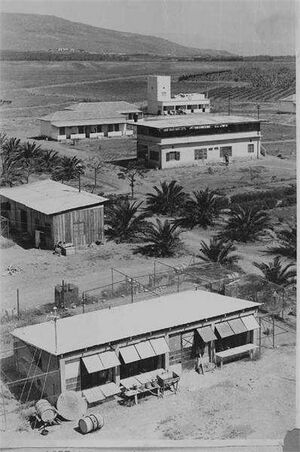Beit Zera
Beit Zera
בֵּית זֶרַע | |
|---|---|
 | |
| Coordinates: 32°41′20″N 35°34′24″E / 32.68889°N 35.57333°E | |
| Country | File:Flag of Israel.svg Israel |
| District | Northern |
| Council | Emek HaYarden |
| Affiliation | Kibbutz Movement |
| Founded | September 1927 |
| Founded by | Austrian-Jewish and German-Jewish immigrants |
| Population (2022)[1] | 624 |
| Website | www |
Beit Zera (Hebrew: בֵּית זֶרַע, lit. "House of Seed")[2] is a kibbutz in northern Israel. Located on the southern shore of the Sea of Galilee, it falls under the jurisdiction of Emek HaYarden Regional Council. As of 2022 it had a population of 624.[1]
History
In 1920, pioneers from Degania Alef founded kibbutz Degania Gimel south of Degania Bet at the site of the future kibbutz Beit Zera.[2] Separately, another group of Jewish pioneers from Germany and Austria, who belonged to the Blau-Weiss movement and had prepared for their task at the Markenhof Farm from southwest Germany near Freiburg, was established in 1921 in Petah Tikva.[3] In 1922 Degania Gimel was disbanded and its residents moved to the Jezreel Valley where they founded kibbutz Ginegar. In 1926 the Markenhof group moved to the Galilee and settled at Umm Juni,[3] the place where Degania Alef once started from at the end of 1909. The community founded in 1926 was a kvutza, was first known as Markenhof or Kfar Gun, was financed at least in part by Keren Hayesod, was allotted 1,500 dunam of land, and had (either in 1926 or in 1933) 38 inhabitants.[4][5] In 1927 the huts at Umm Juni were destroyed by an earthquake and the group moved in September 1927 to the old Degania Gimel site, where they established a new, permanent kibbutz settlement which they called Kfar Nathan.[3][6][7] In 1947, Beit Zera had a population of 500.[8] During the 1948 Arab–Israeli war, the villagers continued their agricultural work despite shelling from Syrian and Iraqi troops as well as from the Arab Legion.[8]

Economy
In addition to agriculture, Beit Zera owns Arkal, a plastic products factory.[9]
Notable people
- Deni Avdija (born 2001), NBA professional basketball player
References
- ↑ 1.0 1.1 "Regional Statistics". Israel Central Bureau of Statistics. Retrieved 21 March 2024.
- ↑ 2.0 2.1 Etan Bloom (2011). Arthur Ruppin and the Production of Pre-Israeli Culture. Studies in Jewish History and Culture (31). Leiden: Brill. p. 206. ISBN 978-90-04-20379-2. Retrieved 9 January 2016.
As the number of members in the first Degania increased, they decided to divide the group and its lands into two groups and established Degania B. Later they established a third group, Degania C (degania gimel), which later became Kibbutz Beit Zera (meaning in Hebrew: the house of seed/semen). (Footnote 247, p 206)
- ↑ 3.0 3.1 3.2 Beit Zera - Kibbutz Labour Movement (in Hebrew)
- ↑ The Encyclopedia of Jewish Knowledge, "Agriculture", p. 17. Jacob de Haas (editor), 1944 (3rd edition, first published in 1934), Behrman's Jewish Book House, New York [1]
- ↑ Jessie Sampter (editor), Modern Palestine: A Symposium, p. 388. Hadassah, The Women's Zionist Organization of America / J. J. Little and Ives Co., New York 1933 [2]
- ↑ Markenhof Glasmalerei-Entwürfe von Friedrich Adler und die ausführenden Glaskunstanstalten Gesellschaft für Geschichte und Gedenken (in German)
- ↑ Markenhof Farm Blau-Weiss (in German)
- ↑ 8.0 8.1 Jewish National Fund (1949). Jewish Villages in Israel. Jerusalem: Hamadpis Liphshitz Press. p. 92.
- ↑ Kibbutzim successfully embrace the capitalist spirit
External links
- Beit Zera official website (in Hebrew)
- Map showing the site "Kefar Gun", 1943. The National Library of Israel, Eran Laor Cartographic Collection